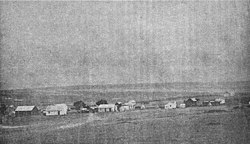AY Honors/Gold Prospecting/Answer Key
Template:Unreferenced The Witwatersrand Gold Rush was a gold rush in 1886 that led to the establishment of Johannesburg, South Africa.
There had always been rumours of a modern-day "El Dorado" in the folklore of the native tribes that roamed the plains of the South African highveld, and the gold miners that had come from all over the world to seek out their fortunes on the alluvial mines of Barberton and Pilgrim's Rest, in what is now known as the province of Mpumalanga.
But it was not until 1886 that the massive wealth of the Witwatersrand would be uncovered. Scientific studies have pointed to the fact that the "Golden Arc" which stretches from Johannesburg to Welkom was once a massive inland lake, and that silt and gold deposits from alluvial gold settled in the area to form the gold-rich deposits that South Africa is famous for.
Discovery
It is believed that it was a Sunday in March 1886 that an Australian gold miner, George Harrison, stumbled across a rocky outcrop of the main gold-bearing reef. He declared his claim with the then-government of the Zuid Afrikaanse Republiek (ZAR), and the area was pronounced open diggings. His discovery is recorded in history with a monument where the original gold outcrop is believed to be located, and a park named in his honour. Ironically, Harrison is believed to have sold his claim for less than 10 Pounds before leaving the area, and he was never heard from again.
Founding of Johannesburg
It did not take long for fortune-seekers from all over the world to flock to the area, and soon what was a dusty mining village known as Ferreira's Camp was formalised into a settlement. Initially, the ZAR did not believe that the gold would last for long, and mapped out a small triangular piece of land to cram as many plots onto as possible. This is the reason why Johannesburg's central business district streets are so narrow.
Within 10 years, the town was already the largest in South Africa, outstripping the growth of Cape Town, which was more than 200 years older. The gold rush saw massive development of Johannesburg and the Witwatersrand, and the area remains the prime metropolitan area of South Africa.
Second Boer War
The Witwatersrand Gold Rush was a major contributing factor of the failed Jameson Raid of 1895 to 1896, and of the outbreak of the Second Boer War in 1899. Boer resentment over the large number of foreigners (Uitlanders) in the Witwatersrand led to heavy taxes and the denial of voting rights for the gold miners, and in response the uitlanders and the British owners of the mines began to pressure the overthrow of the Boer government.
es:Fiebre del oro de Witwatersrand pt:Febre do ouro de Witwatersrand

